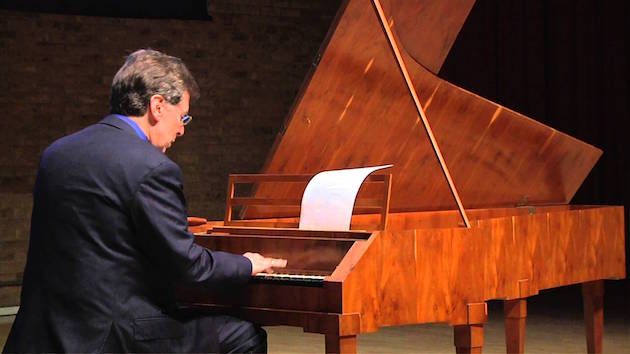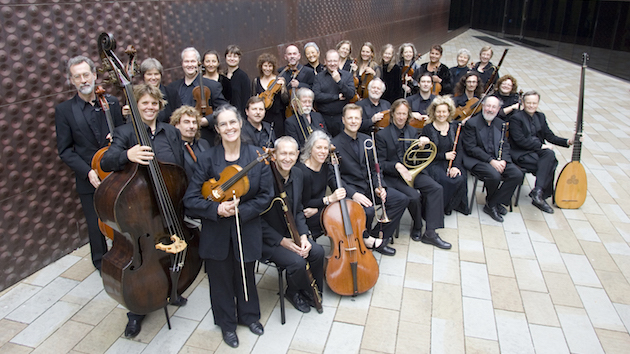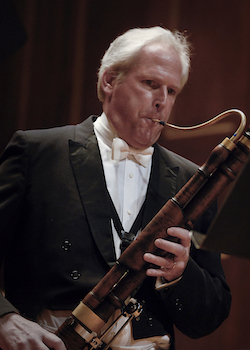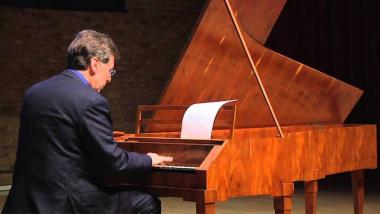
Despite the fire that badly damaged its long-time East Bay home in the First Congregational Church of Berkeley, the Philharmonia Baroque Orchestra’s season-opening concert at Lafayette-Orinda Presbyterian Church, was a festive, triumphant affair. In an all-Beethoven program bolstered by fortepianist Robert Levin, the orchestra made a compelling case for playing this music in historically-informed style with 18th-century instruments.
Levin performed the Concerto No.3, on a G. Hendrich Guggenberger, a Neapolitan fortepiano originally built circa 1820. This instrument, with its delicate, wood construction and six-octave range hardly resembles the cast iron-framed box with a thundering roar and seven-plus octave range that the modern piano became, thanks to the industrial revolution.
Levin stands alone in the world today for interpretation of classical concertos, partly because he adds the improvisations that were expected during the classical period. Academics and pedagogues have forever argued how Beethoven or other composers would have performed their own compositions, but one thing is quite certain: Improvisation was an integral component of a performance. In the case of Beethoven’s Concerto No.3, the cadenzas that we normally hear today weren’t even written by the composer until years after it was first performed and published. Mozart wrote cadenzas only as an example to lesser pianists who could not improvise their own.
Levin still paid an homage to Beethoven’s own cadenza in the first movement, with a tremolo that imitates the orchestra, but the triad theme was in its second inversion (G-C-E-flat) and Levin took off from there. With torrential arpeggios and raging chromatic scales that pushed the instrument to its limit, Levin evoked the mental image of the composer himself premiering it in 1803. There was even a moment when some of the orchestra members thought the cadenza was coming close to an end, and lifted their instruments, only to put them down again. It was a thrilling ride full of anticipations, uncertainties, risks, and surprises.
The tonal quality of the circa-1820 instrument deserves a mention. With its small hammers striking thin strings, the instrument does not come close to the range of dynamics offered by modern pianos. In particular, notes in the treble section do not possess the sustained, singing quality, leaving them sounding more plucked and muted. This produced a striking contrast with the long, sustained notes offered by the accompaniment. Levin’s deft articulations, particularly in the third movement, along with various, spontaneous embellishments, brought it into perfect balance with the orchestra.

The Pastoral Symphony, which came after the intermission also showed how historically informed techniques enhance the music in performance. Nearly all of the string sections employed Baroque bowing technique, which applies less pressure to the strings, along with far more restrained vibrato, when it was used at all. Combined with nonferrous strings, the tone, full of warmth but without gratuitous voluptuousness, matched the disciplined direction that conductor Nicholas McGegan took.
Philharmonia’s strings shed the metallic bite that too frequently contaminates the sound of modern orchestras, which are often pushing the limits of the instruments themselves, tuning at A=442 Hz or even higher. (The concert tuning was lower than modern pitch but not quite as low as the Baroque’s A=415)

The overall effect was to fill the hall with the warm, verdant glow of rolling hills. In the first movement, no passage was hurried, but the scenery moved along as if on a brisk hike. Bassoonist Andrew Schwartz’s solo, in particular, brought serenity to the second movement, yet the storm movement gave ample opportunity for timpanist Kent Reed to shake the air with thunderbolts.
Stepping back from hyper-connected, digital modernity and immersing in the sounds of a preindustrial age connects us to the history we share through music. It is a modern remapping, a reminder of the paths that were taken before us, even though we have become accustomed to doing things differently today. And knowing our past helps us understand our present better.

